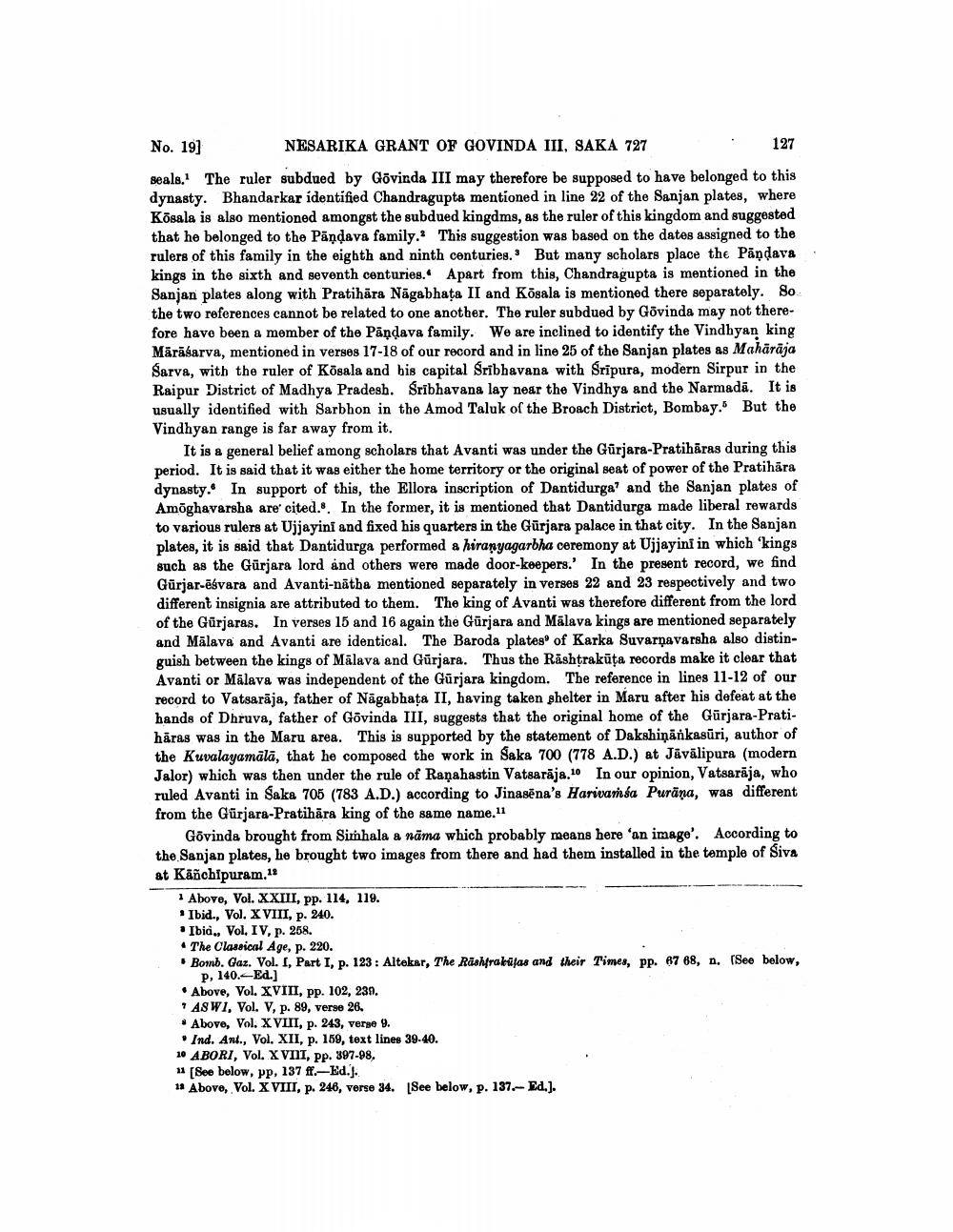________________
No. 19]
NESARIKA GRANT OF GOVINDA III, SAKA 727
.
127
seals. The ruler subdued by Govinda III may therefore be supposed to have belonged to this dynasty. Bhandarkar identified Chandragupta mentioned in line 22 of the Sanjan plates, where Kösala is also mentioned amongst the subdued kingdms, as the ruler of this kingdom and suggested that he belonged to the Pandava family. This suggestion was based on the dates assigned to the rulers of this family in the eighth and ninth centuries. But many scholars place the Pandava kings in the sixth and seventh centuries. Apart from this, Chandragupta is mentioned in the Sanjan plates along with Pratihara Nagabhata II and Kösala is mentioned there separately. So the two references cannot be related to one another. The ruler subdued by Govinda may not therefore have been a member of the Pandava family. We are inclined to identify the Vindhyan king Mārāśarva, mentioned in verses 17-18 of our record and in line 25 of the Sanjan plates as Mahārāja Sarva, with the ruler of Kõsala and his capital Srībhavana with Sripura, modern Sirpur in the Raipur District of Madhya Pradesh. Srībhavana lay near the Vindhya and the Narmadā. It is usually identified with Sarbhon in the Amod Taluk of the Broach District, Bombay. But the Vindhyan range is far away from it.
It is a general belief among scholars that Avanti was under the Gürjara-Pratihāras during this period. It is said that it was either the home territory or the original seat of power of the Pratihāra dynasty. In support of this, the Ellora inscription of Dantidurga' and the Sanjan plates of Amõghavarsha are' cited. In the former, it is mentioned that Dantidurga made liberal rewards to various rulers at Ujjayini and fixed his quarters in the Gürjara palace in that city. In the Sanjan plates, it is said that Dantidurga performed a hiranyagarbha ceremony at Ujjayini in which 'kings such as the Gurjara lord and others were made door-keepers. In the present record, we find Gürjar-ēsvara and Avanti-nátha mentioned separately in verses 22 and 23 respectively and two different insignia are attributed to them. The king of Avanti was therefore different from the lord of the Gurjaras. In verses 15 and 16 again the Gurjara and Mälava kings are mentioned separately and Mālava and Avanti are identical. The Baroda plates of Karka Suvarnavarsha also distinguish between the kings of Mālava and Gurjara. Thus the Rashtrakūta records make it clear that Avanti or Mālava was independent of the Gurjara kingdom. The reference in lines 11-12 of our record to Vatsarāja, father of Nāgabhata II, having taken shelter in Maru after his defeat at the hands of Dhruva, father of Govinda III, suggests that the original home of the Gurjara-Pratihāras was in the Maru area. This is supported by the statement of Dakshiņánkasūri, author of the Kuvalayamālā, that he composed the work in Saka 700 (778 A.D.) at Jāvālipura (modern Jalor) which was then under the rule of Ranahastin Vatsarāja. In our opinion, Vatsarāja, who ruled Avanti in Saka 705 (783 A.D.) according to Jinasena's Harivamsa Purāņa, was different from the Gürjara-Pratihāra king of the same name.11
Govinda brought from Sinhala a nāma which probably means here 'an image'. According to the Sanjan plates, he brought two images from there and had them installed in the temple of Siva at Käñchipuram.
1 Above, Vol. XXIII, pp. 114, 119. • Ibid., Vol. XVIII, p. 240. • Ibid., Vol. IV, p. 258. • The Classical Age, p. 220. Bomb. Gaz. Vol. 1, Part I, p. 123 : Altekar, The Rashtraktifas and their Times, pp. 67 68, n. (See below,
P, 140.-Ed.] • Above, Vol. XVIII, pp. 102, 239. * ASWI, Vol. V, p. 89, verse 26. . Above, Vol. XVIII, p. 243, verse 9.
Ind. Ant., Vol. XII, p. 159, text lines 39-40. 10 ABORI, Vol. XVIII, pp. 897-98. 11 [See below, pp, 137 ff.-Ed.). 13 Above, Vol. XVIII, p. 246, verse 34. (See below, p. 137.-Ed.).




